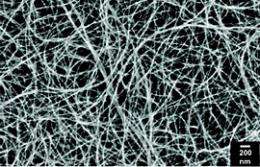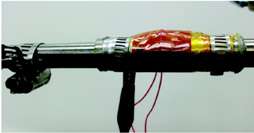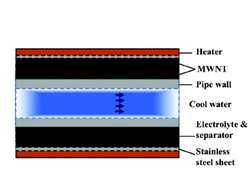Nanotube Thermocells Hold Promise as Energy Source

(�鶹��ԺOrg.com) -- A study published in the American Chemical Society's journal Nano Letters reveals that thermocells based on carbon nanotube electrodes might eventually be used for generating electrical energy from heat discarded by chemical plants, automobiles and solar cell farms. Dr. Ray Baughman, director of the Alan G. MacDiarmid NanoTech Institute, collaborated with an international team of researchers on the findings.
Efficiently harvesting the thermal energy currently wasted in industrial plants or along pipelines could create local sources of clean energy that in turn could be used to lower costs and shrink an organization’s energy footprint.
The new thermocells use nanotube electrodes that provide a threefold increase in energy conversion efficiency over conventional electrodes.
One of the demonstrated thermocells looks just like the button cell batteries used in watches, calculators and other small electronics. One key difference, however, is that these new thermocells can continuously generate electricity, instead of running down like a battery. The research netted other thermocells, as well, including electrolyte-filled, textile-separated nanotube sheets that can be wrapped around pipes carrying hot waste streams of manufacturing or electrical power plants. The temperature difference between the pipe and its surroundings produces an electrochemical potential difference between the carbon nanotube sheets, which thermocells utilize to generate electricity.
Dr. Ray Baughman, the Robert A. Welch Chair in Chemistry and director of the Alan G. MacDiarmid NanoTech Institute, collaborated with an international team of researchers from the U.S., Australia, China, India and the Philippines.
“We have long been the Energy State, because Texas has oil and gas in the ground and Texans have invented key technologies for bringing them to the surface,” Baughman said. “But, being the Energy State in the future must increasingly include discovering new means for extracting all forms of energy. Harvesting waste thermal energy is just one direction our NanoTech Institute has taken with our international team to help provide an energy enabled future for Texas and the world.”

The research team estimates that multi-walled carbon nanotubes in large thermocells could eventually produce power at a cost of about $2.76 per watt from freely available waste energy, compared with a cost of $4.31 per watt for solar cells, which can only be used when the sun is shining. On a smaller scale, button cell sized thermocells could be used to power sensors or electronic circuits.
The new thermocells take advantage of the exceptional electronic, mechanical, thermal and chemical properties of carbon nanotubes. The nanotubes’ giant surface area and unique electronic structure afforded by their small diameter and nearly one-dimensional structure offer high current densities, which enhance the output of electrical power and the efficiency of energy harvesting.
“International collaboration with teammates from four universities in the United States, Australia and India enabled our initial breakthrough,” Baughman said. “Researchers from Dr. Gordon Wallace’s Intelligent Polymer Research Institute in Wollongong Australia have long worked side-by-side with us to solve key technological problems. Dr. Baratunde Cola’s NanoEngineered Systems and Transport Lab at the Georgia Institute of Technology, provided a key missing link. We will together work in the future to realize the full commercial potential of our technology, which requires further breakthroughs. I am especially proud that Stephanie Stoughton earned her place as a co-author while a Texan high school student in our NanoExplorers program.”

Stoughton, a former George A. Jeffrey NanoExplorer, is a sophomore studying materials science and engineering at Cornell University.
“My contribution was near the project’s beginning,” Stoughton said. “I did some of the early testing and helped create the buckypaper used in the nanotube electrodes.”
Stoughton credits her experience at the NanoTech Institute for offering her access to hands-on research as early as high school.
“UT Dallas and the NanoTech Institute have time and again given students unique opportunities to participate in cutting-edge research and work with top notch scientists,” Stoughton said. “My generation is one likely to face profound energy issues, and I’m proud to be a part of achieving sustainable solutions now as opposed to later, when energy issues are likely to be even more problematic.”
More information: Paper:
Provided by University of Texas at Dallas


















